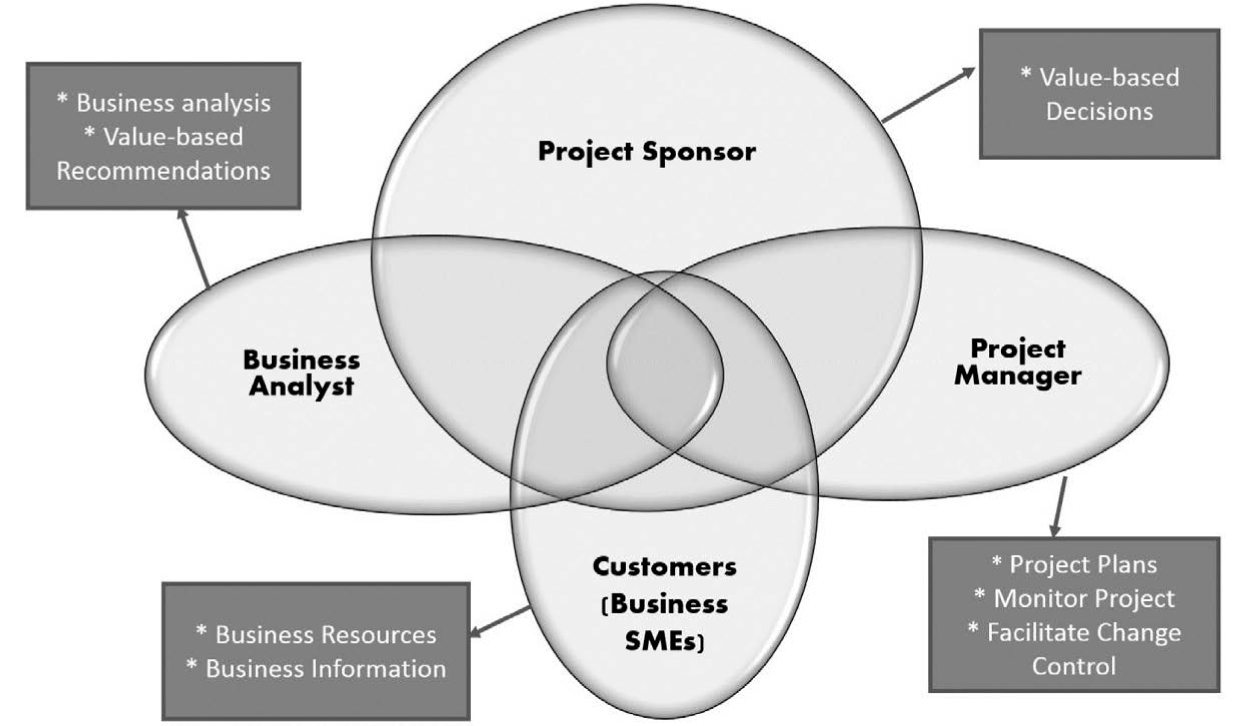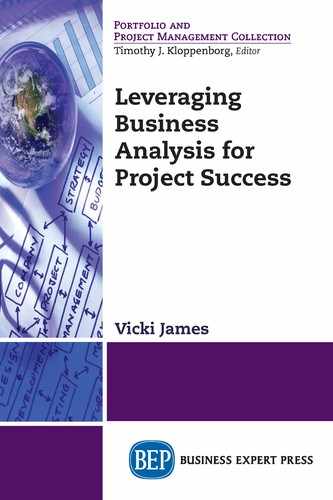Now that we have thoroughly explored what a business analyst can do to support your project and bring value to the business, let’s take a moment to review roles associated with great projects. To do this, we will go back to Figure 4 that was presented in Chapter 2—Vision for Tomorrow.
The business analyst cannot be all alone in bringing value to the project. It is a team effort involving many players.
Project Customers (Business SMEs)
We will start with the Project Customer (or Business SME) of the project. This is the person or people that represent the business that will use the solution that is developed. They are the ones that have the inside knowledge to the processes, barriers, and needs of the business to be successful. As such, they need to be a contributing player to the overall project as a member of the project team. They are the ones that need to supply the resources for the business analyst and the rest of the team so they can get the information that they need to recommend strategies that will bring the greatest value to the project. It is important that they are active participants throughout the project, and especially during requirements gathering. What we find on many challenged projects is that these valuable players are often missing from critical discussions and activities. The customer must dedicate time to meet with the business analyst and other project team members to elicit requirements, understand the assumptions and constraints, and provide feedback on the direction that the project is taking. If the customer does not care enough about the project to provide the time and resources needed for the project team, the project will be sure to suffer.

Figure 22 The Project Power Team
Project Manager
The project manager is responsible for coordinating all the team efforts in order to ensure that efficient processes, best practices, and coordination across the project can take place in the most efficient way possible. This is the role that is responsible for trying to balance needed scope with the budget and schedule available for the project, which is not an easy task. The project manager serves as a leader to the project team in helping to motivate staff, provide structure and direction for the processes of the project, and making sure that all the pieces fit together for a successful project. With business analysis activities being just one piece of the overall picture, the project manager has the responsibility to ensure that the business analyst’s pieces fit in with the rest of the project. This means sorting the plans of the business analyst into the overall project plan and ensuring that it all works together.
With the project manager having such a strong interest in the budget and schedule of the project, it becomes critical that they have a firm handle on changes to the project by ensuring that change control processes established for the project are followed. It is the responsibility of the project manager to ensure that the business impact is analyzed by the business analyst and that the effort and risk to the project are called out by the project team and providing information to the business analyst and sponsor to support a recommendation that the project can support and will bring value.
I was once presenting this topic at a local PMI meeting where project managers in the audience took exception to the idea that business analysis was not a function of the project manager. The concern was that if the business analyst did all the analysis and recommendations regarding value to the project, then the project manager was relegated to being a schedule coordinator. This cannot be further from the truth. Separating the analysis of value to the business from analysis of impacts on the project timeline and schedule ensures that a balanced decision can be made.
I worked with a project manager early in my career, where it felt like our meetings were often mini-boxing matches. We would debate the merits of product features that would enhance the value of the solution and the impact on the schedule and cost of the project. This provided a venue to thoroughly explore the impacts of both sides and present these findings to the sponsor for the best possible decision on the project.

Figure 23 PM and BA Sparring
Project Sponsor
The project sponsor is the owner of the project, the one accountable for the investment and who will answer to the CEO or Board of Directors if the project does not bring value. They are the ultimate decision maker in the project scope, schedule, and budget. The project sponsor should rely on the expertise of (a) the business analyst and understanding of the value of the decisions to be made, (b) the project manager in understanding the impact to the overall project, and (c) the project customer in ensuring that they are ready for a new solution and that the solution will meet their expectations.
So circling back to the business analyst, we see that their responsibility is to make value-based recommendations in support of the project. This includes understanding what the project sponsor finds valuable, what the project customers expect, and what the project manager determines can be accomplished within the constraints of the project.
These four roles together create the perfect project oversight team. The project manager and project sponsor meeting in isolation will not bring the same value as that resulting from including the perspectives of the business analyst and subject matter expert. Some project managers and project sponsors may be surprised or even reluctant to hear that they should include, at a minimum, the business analyst and also a subject matter expert in their project oversight meetings. But having all of these roles at the project table will ensure that all perspectives of the project are taken into account and presented to the project sponsor in order to get the best decisions possible.
Flavors of Business Analysts
I also want to spend some time discussing the different types of business analysts we have in our organizations. Usually, a business analyst is thought of as a “project requirements gatherer”. While it is true that a lot more understanding of analysis necessary for great requirements is needed, business analysis in and of itself goes well beyond project requirements.
Business analysis at the strategic or organizational level is often disguised, or folded into other organizational roles. You can find business analysts hiding anywhere you see roles within the organization that provides advice to the executive management. These are the staff that are often given special projects to produce a report and recommend a course of action to the organization. It really doesn’t matter what somebody’s title is. If they do business analysis, then they are a business analyst. What does matter is that those people who do business analysis understand what business analysis is and that there are best practices to support the work.
Business Analysis Best Practices
The point of this book is to help you leverage best practices in business analysis to bring the greatest value of your projects to your organization. In order to do this your business analysts need to know where to find, and how to utilize, the best practices available. For those dedicated to doing business analysis within the context of a specific project or program, they look to either IIBA’s A Guide to the Business Analysis Body of Knowledge® (BABOK® Guide) or to PMI references for the PMI Professional in Business Analysis examination content.22 PMI recently published Business Analysis for Practitioners—A Practice Guide23 and further plans to develop and publish a Requirements Body of Knowledge in 2015.
IIBA and the PMI generally agree on business analysis best practices. The difference between the two resources is the packaging of those best practices. The BABOK® Guide has been evolving since 2006. This resource is grounded and mature in how it presents best practices in business analysis. The PMI is playing catch-up in the development of best practices resources. While currently there are not many specific dedicated reference sources for business analysis, the information that has been put together to support the PMI-PBAMSM credential aligns well with the A Guide to the Project Management Body of Knowledge (PMBOK® Guide). Using these resources may aid in the collaboration and understanding of roles between the business analyst and the project manager.
For business analysts at the organizational and strategic level, the BABOK® Guide is the best source of best practices to support business analysis activities.
Regardless of the roles of business analyst to play in your organization, or those doing business analysis activities, I would highly recommend that organizations encourage these people to study business analysis to learn, understand, and apply best practices within your organization. Organizations should be looking for business analyst professionals who have proven their expertise through credentials. Getting a credential is so much more than just passing a test. Both IIBA and PMI require that individuals have a significant amount of experience and education before they can apply to take the test. Passing the test is an indication of understanding best practices and how they apply in the real world. Finally, holding a credential in business analysis requires continuing education. Both IIBA and PMI require 20 professional/continuing development units each year to maintain the credential. I highly encourage organizations to support their current business analysts in getting certified, and to look to certified individuals to fill future business analysis jobs.
22Reference materials for PMI® Professional in Business Analysis (PMI-PBAMSM) Examination—http://www.pmi.org/~/media/PDF/Certifications/PBA_Reference_list_v1.ashx.
23Project Management Institute. (2014). Business Analysis for Practitioners: A Practice Guide. Newtown Square, PA: Project Management Institute.
